If you’re looking for an email marketing solution and considering Drip vs ActiveCampaign, you’re on the right track. Both are powerful platforms worth considering.
However, each has its target audience, and this post discusses what those are to help you determine which tool suits your business best.
Additionally, understanding the unique features and pricing structures of Drip and ActiveCampaign will enable you to make an informed decision for your email marketing needs.
Drip vs ActiveCampaign: A quick overview
As mentioned, Drip and ActiveCampaign are among the top email marketing automation tools. However, they are suitable for different business needs. It’s essential to evaluate your specific requirements and goals to determine which platform will best meet your email marketing objectives.
ActiveCampaign is best known for its powerful marketing and sales automation and wide range of features. Similarly, Drip is a unique email marketing platform with robust automation and segmentation features.
Let’s take a moment to explore how customers have rated each tool on the Shopify App Store, providing valuable insights into the satisfaction levels and experiences of users with these platforms.
- Drip: 4.5 out of 5, 73 reviews
- ActiveCampaign: 4.4 out of 5, 392 reviews
In this Drip vs ActiveCampaign review, we’ll discuss all you need to know about each tool’s features, strengths, weaknesses, and prices. By the end, you’ll know whether either platform suits your business’s needs.
Before delving into the details, let’s start with a concise overview of the key features offered by both platforms for a quick and convenient comparison.
Drip vs ActiveCampaign comparison: Feature by feature
This next section of the Drip vs ActiveCampaign review will give you an in-depth analysis of how each tool’s features compare.
Ease of getting started
Getting started is straightforward with both ActiveCampaign and Drip.
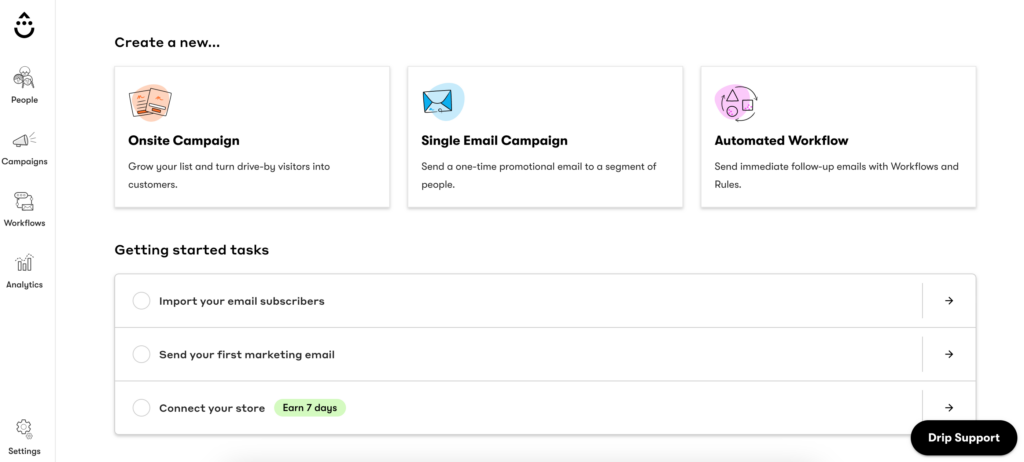
During signup, Drip only asks for your credit card information to start your free trial once you decide to upgrade. You’ll fill out some essential details about your business and complete the process quickly.
It’s a bit different from ActiveCampaign.
Signing up is the most straightforward with ActiveCampaign if you download it from the Shopify app store. The process is smooth, and there is no need to provide any card information.
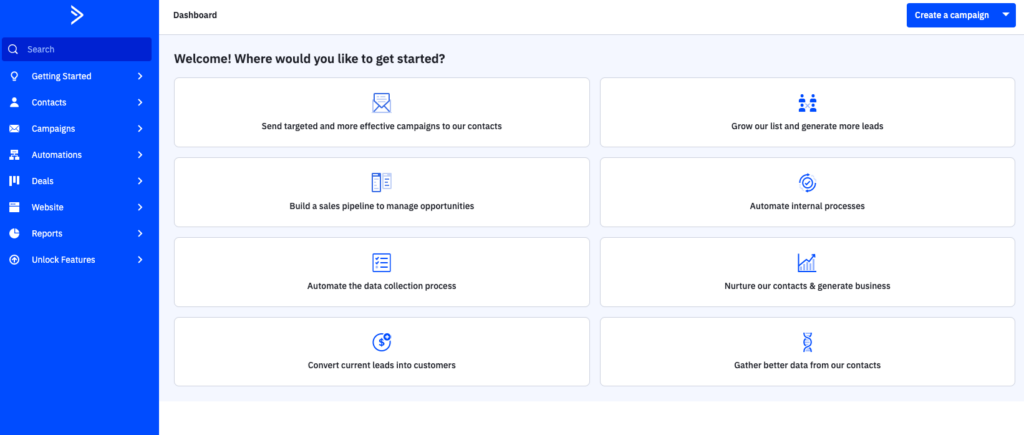
However, if you sign up on the home page, you’ll be asked questions about your business and asked to provide your credit card details.
Otherwise, everything else about the signup process is smooth. ActiveCampaign provides a Getting Started wizard to instruct you on your next steps. Drip also provides video tutorials and guides for each item on the main menu.
ActiveCampaign’s interface is intuitive. However, the menu items and subitems are many, and it may look overwhelming at first glance. Some unique features you’ll find there include:
- A content manager that allows you to access all your campaign uploads from a centralized location.
- Message Variables feature that enables you to tag content blocks, such as signatures, and directly pull them into your email.
- Free design service is available on the Marketing Enterprise plan. ActiveCampaign team helps you build your business email templates.
From this, you can tell that ActiveCampaign was made with established businesses in mind.
The platform offers a wide array of settings, and some of the terminology on the menu items may need to be clarified. You’d need to be an experienced marketer or tech-savvy to keep pace.
Drip’s user interface has a more straightforward, more vibrant outlook. There are only a few menu items that are easy to master and an email editor that is easy to navigate.
Drip wins, as it has fewer settings and a more straightforward user interface.
Building an email campaign
Both tools seem straightforward, but which email editor is easier to use: ActiveCampaign, or Drip?
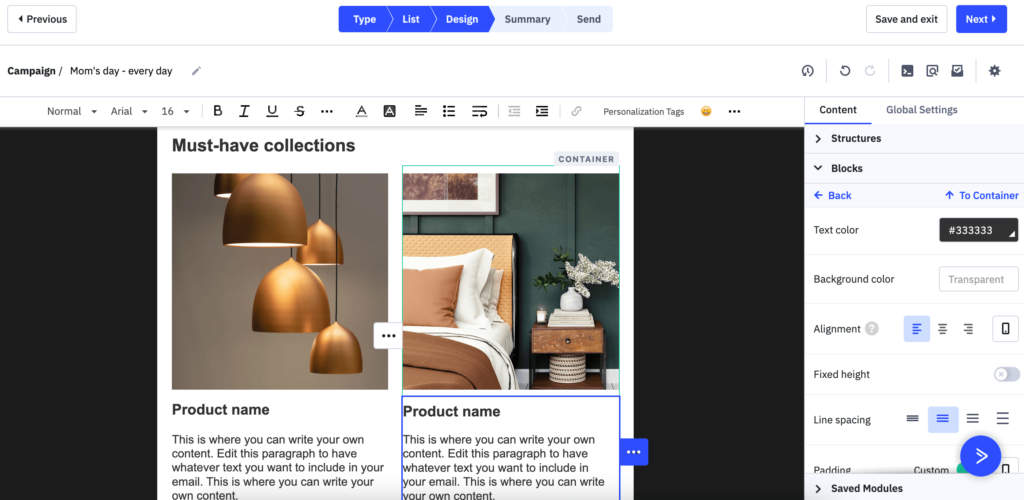
The ActiveCampaign email builder is pretty intuitive. It uses a drag-and-drop feature that makes adding and editing content blocks easy.
You can access your lists and create segments directly from your email builder. You can also add customer information to your subject lines and email body.
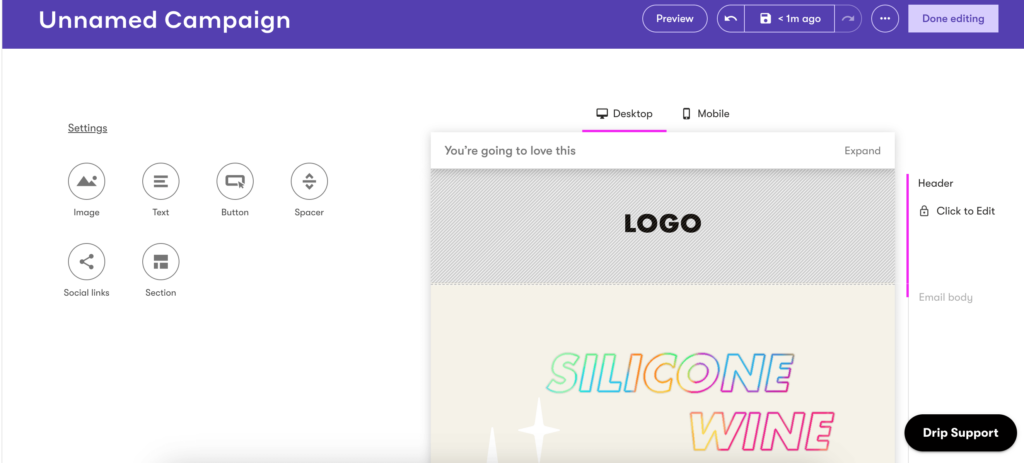
Drip’s email-building function needs some getting used to, as it’s not as intuitive as what’s provided by other top email marketing platforms.
Instead of adding content blocks and items however you like, you’d need to edit your emails by section. If the template you choose has a given number of areas, you cannot add any more, which can be limiting.
It’s also not so easy to add personalization details to the preheader and subject line of the email. But you can make it in the email body easily.
Here’s a quick overview of other email-building features.
ActiveCampaign includes autoresponders, automated email campaigns, and date-based campaigns separately, which gives you a better functionality.
Drip’s email editor is quite limited compared to other competitors’ tools. Simply put, ActiveCampaign offers much more in this category.
ActiveCampaign wins.
Marketing automation
Both platforms have robust automation capabilities that would be sufficient for most businesses. However, in a Drip vs ActiveCampaign situation, ActiveCampaign does more, partly because of its CRM function.

First, both tools offer email automation workflows with a logical flow. But with ActiveCampaign, there are 500+ “recipes” or workflows to automate anything. The platform also categorizes these by industry to make it easy to find what fits.
Drip provides 20+ prebuilt automation workflow templates for various ecommerce use cases. You can send both site-based and behavior-based automation workflows to your ecommerce customers.
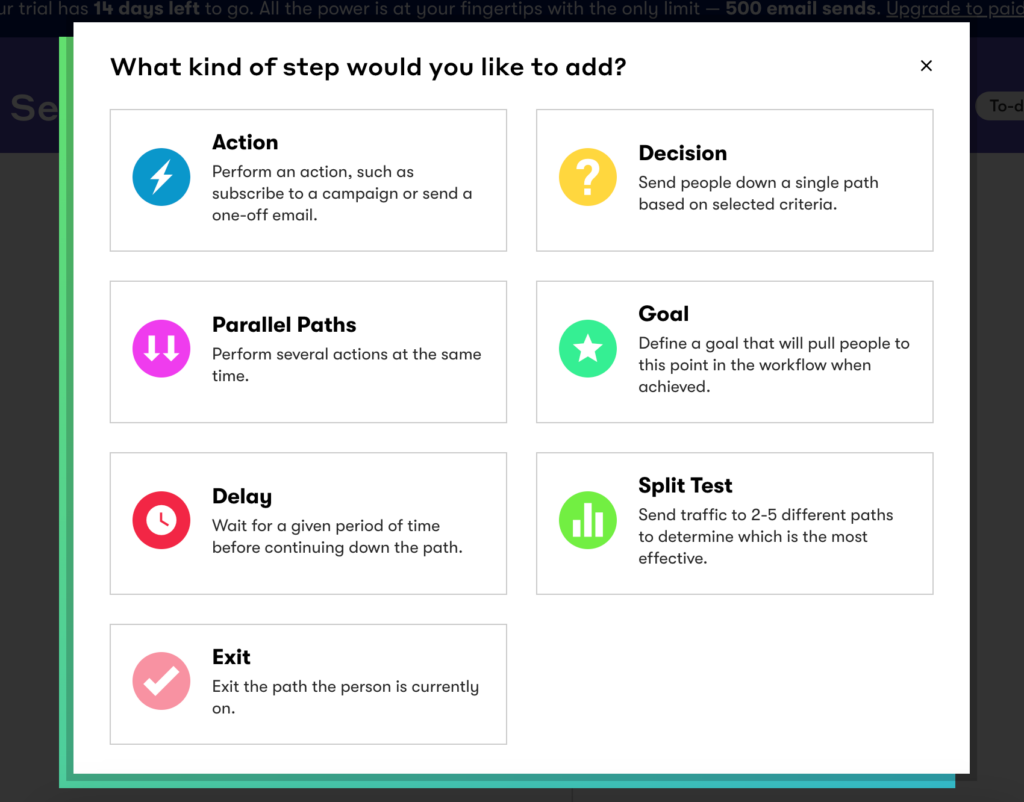
Some popular workflows you can build on Drip include:
- Welcome series
- Browse abandonment emails
- Cart abandonment reminders
- Post first purchase emails
You can also sync Facebook audiences and retarget your Facebook and Instagram prospects with your automated campaigns on Drip. This feature is available on ActiveCampaign as well.
ActiveCampaign is compatible with more channels, allowing you to sync SMS and web push messages into your automated campaigns.
So which tool offers better automation, ActiveCampaign or Drip?
ActiveCampaign is an automation powerhouse that provides hundreds of automation triggers for both sales and marketing use cases. You can integrate it with numerous marketing channels and CRM tools for an even more comprehensive range of functionality.
The automation features are innumerable, which is great for established businesses but can be overwhelming for beginner marketers.
It isn’t to say that Drip’s automation capabilities are anything to overlook. For ecommerce businesses, Drip would be a better choice.
Drip’s automation is flexible, easy to use, intuitive, and provides numerous ecommerce triggers. Moreover, the automation dashboard is also visually appealing.
ActiveCampaign wins, but only because it does more.
Signup forms and landing pages
Signup forms and landing pages help businesses build email lists and reach wider audiences.
This section discusses Drip vs ActiveCampaign’s list-building features.
Drip has several options for how your forms will appear. These include embedded, sidebar, sticky bar, sidebar, slide-in, and popups. You can choose the following trigger settings.
- AI-generated triggering
- Show after X seconds
- Show after X% scroll
- Click trigger
- Manual trigger
- Sitedata trigger
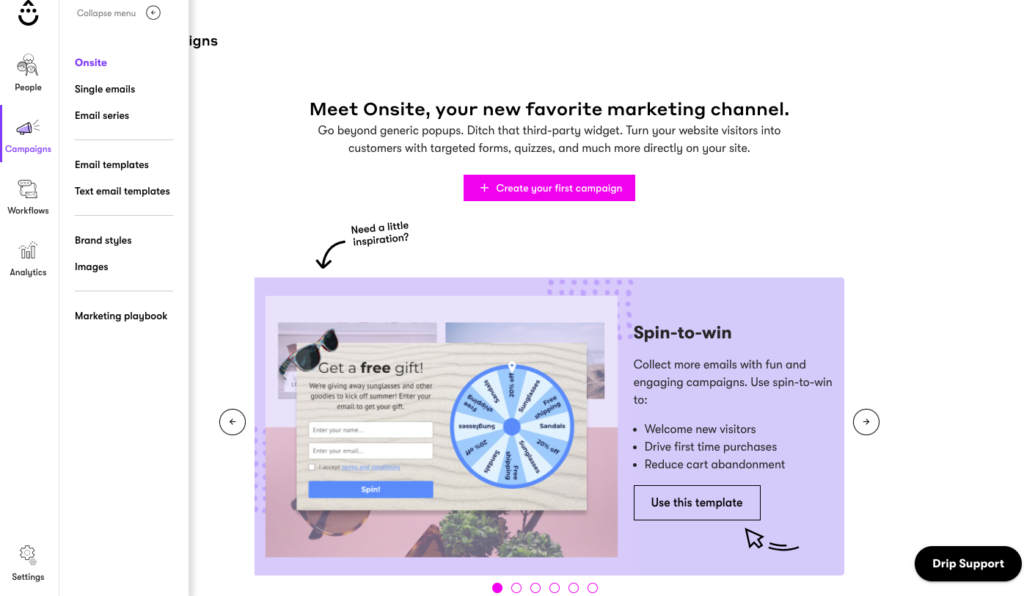
We found Drip’s forms to be quite robust and flexible, too. You can run engaging on-site marketing campaigns that include spin-the-wheel contests, countdown timers, shipping discounts, and surveys.
ActiveCampaign has a rather primary form builder. The platform provides a few layouts that you can customize to match your brand, but that’s about it.
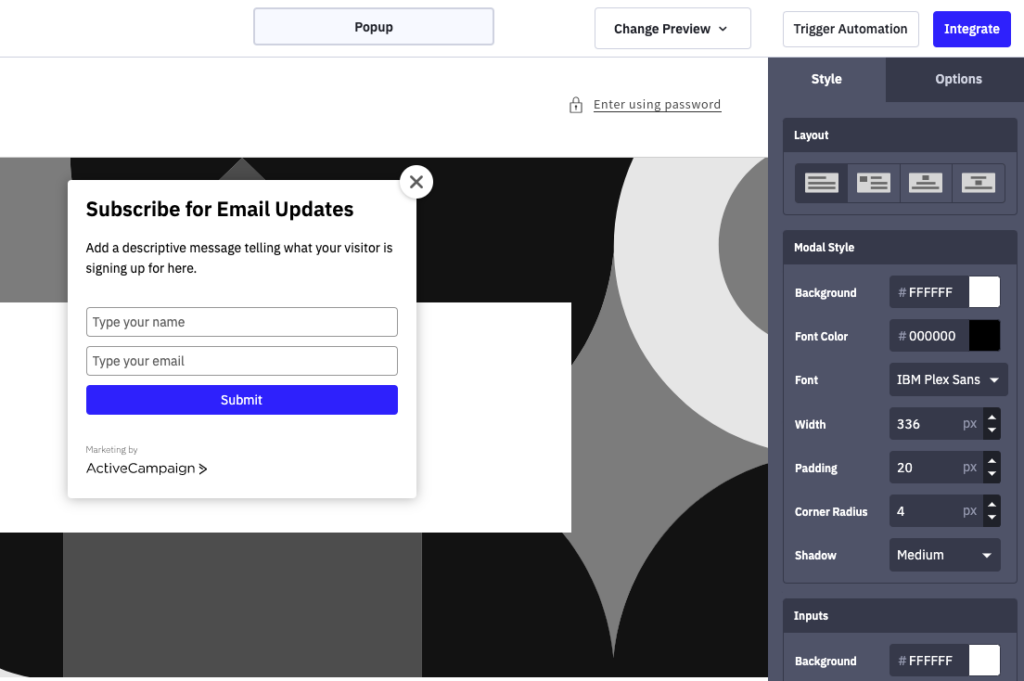
Managing lists is accessible on both Drip and ActiveCampaign. You can manually add tags to your lists and create segments based on these tags.
For ActiveCampaign, the CRM function comes in handy for list management purposes. It allows you to track and manage customer information from one platform and reach them through their preferred communication channel.
We found it unusual that forms appear under the “Onsite Campaign” and “Website” sections of Drip and ActiveCampaign’s menus.
Also, in ActiveCampaign’s interface, the popup label is tagged “modal,” which can be challenging to understand. And unlike Drip, ActiveCampaign lacks a delay setting for popup forms.
Overall, Drip offers everything you might want in terms of signup forms. But lacks landing pages. ActiveCampaign offers primary structures, and the landing pages are only available on high-tier plans.
Drip wins in this category.
Segmentation
Which tool offers better list segmentation, Drip or ActiveCampaign?
Let’s find out.
Drip offers a few ready-to-go audiences. From there, you’d need to build more segments yourself. Meanwhile, ActiveCampaign doesn’t provide any prebuilt components.
Both tools have robust segmentation capabilities, so building segments shouldn’t be a problem. You can combine customer, store, and marketing data to build targeted segments and increase audience engagement.
Some segmentation options offered by Drip are based on the following:
- Email activity
- Onsite forms
- Orders and products
- Review activity
- Loyalty programs
- Tags and fields
With ActiveCampaign, you can segment your audiences by
- Contact details
- Customer email actions
- Geography
- Attribution
- Site and event data
- Account details
- Customer shopping behavior
- Deal details and deal fields
It’s a tie. Both tools have robust audience segmentation features.
Analytics
ActiveCampaign has an extensive reporting feature. You can track several reports, including:
- Site tracking reports
- Campaign and ecommerce automation reports
- Customer engagement reports and link tracking
- Event tracking
- Revenue and store performance reports (available on the Plus plan or higher)
- Attribution and custom reports (available on the Professional plan and up).
The standard reporting metrics are comprehensive, and you can easily track your open, click, unsubscribe, and bounce rates. You can also track geolocation reports and social media mentions and shares.
The Lite plan has minimal reporting features. For instance, you cannot access ecommerce reports, making them unsuitable for online store owners. Most popular email marketing tools provide ecommerce reports for customers on all plans.
Drip also provides excellent reports, but the options are fewer than ActiveCampaign’s. You can track the following elements:
- Email campaign engagement rates
- Total revenue
- Event-based reports
- Average order value
- Number of unsubscribes
- Number of clicks on links
- Recent activity metrics
- Site traffic
- Conversion rates and more
You’ll also be able to access your revenue and store reports once you integrate your online store.
ActiveCampaign provides more detailed standard reports and a comprehensive range of advanced reporting options. The only downside is that they’re not available on all plans.
ActiveCampaign wins, as it offers more comprehensive features.
Customer support
ActiveCampaign offers email and chat support for customers. There are also some resources to refer to. These include:
- A knowledge base
- Video guides and tutorials
- A community forum
- ActiveCampaign University
Drip customers have access to the following customer support options:
- Email support from 9 am to 5 pm Central Time, Monday to Friday
- Live chat support from 9 am to 5 pm Central Time, Monday to Friday for users on $99+ plans
- Live walkthroughs sessions on the platform every Tuesday and Thursday
- Podcasts, how-to guides, and a help center.
Both tools lack phone support. Drip doesn’t offer customer support on the weekends or free trials.
It’s a tie; as both tools have limited customer support options.
Integrations
Drip provides native integrations with Shopify, BigCommerce, and WooCommerce. There are also 100+ integrations with other third-party platforms. This includes Zapier, which allows you to integrate with any other app unavailable on the list.
ActiveCampaign provides way more integrations with key third-party platforms. With 800+ integrations, it’ll be easier to find apps for different functions, including CRM, payment gateways, shipping tools, Zapier, and more.
The platform also contains a native integration with ecommerce platforms like WooCommerce, Shopify, Magento, BigCommerce, and Square. However, this feature is not accessible on the Lite plan.
Drip wins, because it allows integrations to all customers.
Compatibility with other marketing channels
Drip lacks built-in features to connect with other marketing channels. However, you can connect to other third-party applications like Facebook Audiences and retarget your social media prospects.
ActiveCampaign is compatible with more marketing channels. With an SMS add-on (available only on the Plus plan and higher), you can sync your email marketing campaigns with SMS messages.
Other opinions include:
- Web push messages
- Facebook lead Ads
- FacebookAudiences (Plus plan and higher)
- Site messages ( Professional plan and higher)
ActiveCampaign is compatible with many more marketing channels than Drip.
ActiveCampaign wins this round.
Drip vs ActiveCampaign: Price Comparison
Both Drip and ActiveCampaign are expensive compared to other email marketing platforms.
They also don’t offer a free plan, but you can get started on a 14-day free trial with limited features.
For Drip, you can explore all the features during your free trial, including:
- The 100+ integrations including popular email marketing platforms
- The visual builder
- Automated workflows based on customer behavior
- Modern-looking email templates, etc
However, you wouldn’t be able to send unlimited emails and be limited to a contact list of 500 people.
As for ActiveCampaign, you can only have 100 contacts on the free trial.
Here’s an overview of Drip vs ActiveCampaign’s paid plans.
With Drip, there are no tired plans. The prices are based on your contact list size. This can have both an upside and a downside. The upside is that you can access all features regardless of the size of your contact list.
The downside is that there are no cheaper plans for smaller ecommerce businesses, as everything starts at $39.
With ActiveCampaign, the plans are more expensive than Drip. The lowest tier plan (Lite) costs $39/month and has minimal features. You’ll only access basic marketing automation and reporting.
Other features are blocked, including:
- SMS add-ons
- Ecommerce integrations
- Split automation
- Lead scoring
- Ecommerce reports
- Advanced reporting and analytics
Some features are also locked in the Plus plan, including custom reporting, attribution, and Microsoft Dynamics integration.
Overall, Drip is relatively less expensive than ActiveCampaign. However, it is still more expensive than competitor tools like Omnisend. And since Drip is marketed as an ecommerce automation platform, it is more suitable for ecommerce businesses with a bigger budget.
ActiveCampaign is generally expensive as it offers a wide range of advanced features for both sales and marketing functions. This makes it ideal for established businesses and B2B enterprises.
Drip vs ActiveCampaign: Which one wins?
4.1
3.8
1,000 subscribers – $39
5,000 subscribers – $99
10,000 subscribers – $174
50,000 subscribers – $486
100,000 subscribers – custom pricing
1,000 subscribers – $39
5,000 subscribers – $89
10,000 subscribers – $154
50,000 subscribers – $699
100,000 subscribers – $1,199
- No free plan
- No free plan
- Excellent marketing automation features
- Numerous professionally-designed email templates
- Extended tracking and reporting capabilities
- Comprehensive functionality, including CRM, transactional emails, sales funnels, etc.
- A robust marketing automation
- Outstanding segmentation feature
- Clear, easy-to-use interface
- Flexible pricing based on a contact list
- More expensive than other similar tools
- It might be overwhelming for marketing beginners
- Ecommerce reports are only available on the higher tier plans
- No signup form templates
- More expensive than most similar tools
- A limited email builder
- No landing pages
- Limited customer support options
- Well-established ecommerce businesses
- B2B businesses
- Established ecommerce businesses
- Companies with a set marketing budget
- Ecommerce beginners
- Non-profit organizations
- Solopreneurs
- Small businesses
- Freelancers
- Non-profit organizations
Whether ActiveCampaign or Drip is the best tool for your business depends on your business type, needs, and budget. Hopefully, this ActiveCampaign vs Drip review helps you decide.
If you’re an established ecommerce store, Drip provides robust automation and segmentation capabilities as well as numerous integrations with popular ecommerce platforms.
ActiveCampaign is more suited for established businesses looking for a wide range of functionality. The platform provides robust automation and personalization capabilities for both marketing campaigns and sales deals.
Ultimately, the platform you choose will depend on your needs.
Related picks for you
Our team strives to be accurate and unbiased in reviewing email tools. However, we recognize that mistakes can happen, and it’s essential for us to stay up to date. If you come across any errors or things that need to be reviewed again, please let us know.


Leave a Reply